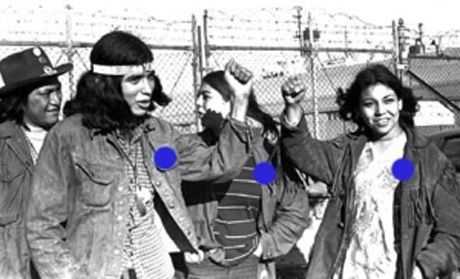Features
You are here
First Nations Education: Harper vs Blue Dots

February 17, 2014
Where is Stephen Harper going with the February 7th announcement of the First Nations Education Act? Probably nowhere, according to several critics.
One of the things that makes the discussion so lively is that the legislation itself has not yet been shared with First Nations, even though reclaiming authority for education has been at the forefront of First Nations’ demands at least as far back as the Red Power movement of the 1960s and 70s. These assertions are hardly surprising, given the horrific and ongoing impact of government-supported and church-operated residential schools.
Background
The negative educational outcomes continue to this day. In the blog âpihtawikosisân, Indigenous writer Chelsea Vowel quotes the statistics: 40 per cent of Aboriginal people aged 20-24 do not have a high school diploma, compared to 13 per cent of non-Aboriginal people, with rates of 61 per cent on reserve (which is where the legislation is to apply) and 68 per cent among Inuit in remote communities. Nine per cent of the Aboriginal population have a university degree compared to 26% among non-Aboriginal people. The lack of opportunity is one factor contributing to the epidemic of Indigenous youth suicides.
One of the biggest hurdles has been inadequate funding. On-reserve education is funded federally, while off-reserve education is funded provincially. Whatever complaints we have about provincial education funding overall, the situation looks good compared to what First Nations face on reserve. Again, according to sources noted in Vowel’s blog, “the federal funding formula for on-reserve schools has been capped at 2 per cent growth per year since 1996 despite the need having increased by 6.3 per cent per year, creating a $1.5 billion shortfall between 19996-2008 for instructional services alone.” And, “unlike their provincial counterparts, First Nations schools receive NO funding for library books, librarian’s salaries, construction or maintenance of school libraries, nor funding for vocational training, information and communication technologies, or sports and recreation. In 2007, there was a need for 69 new First Nation schools across Canada… Funding was only provided for 21 new schools.”
Wealthier First Nations have been able to make up the difference with their own revenues, but (a) they shouldn’t have to, given the federal government’s fiduciary responsibilities, and (b) most First Nations don’t have that kind of financial capacity.
The funding “commitments” announced by Harper include $1.252 billion over three years, beginning in 2016-17 (post-election), $500 million over seven years for infrastructure, and $160million over four years starting 2015/16 for an Implementation Fund or Education Enhancement Fund.
Colonial document
But not sharing the legislation is typical of the duplicitous treatment of First Nations by Harper. And the head of the Assembly of First Nations (AFN) doesn’t come out looking too well either. The announcement of the legislation was staged at the Kainai High School auditorium on the Blood Reserve in Alberta, featuring Harper, Bernard Valcourt (Minister of Aboriginal Affairs and Northern Development – AANDC) and Shawn Atleo, Grand Chief of the AFN.
According to the blog Elle-Maija Tailfeathers, Harper was earlier made an honourary member of the tribe by its Chief Charles Weaselhead, though many members of the tribe were unaware of and not consulted about the honour. According to the blog, “Many tribal members were not granted access into the … gym (auditorium)… and a peaceful protest also took place outside the school.” As other critics have argued, the blog notes, “The AFN may have participated in the negotiation process and the drafting of this legislation but they do not have the authority to speak on behalf of Treaty Nations.”
It would appear that very few Chiefs, even at executive levels of the AFN were properly consulted before the legislation was announced. As a result, most Nations are not supporting the announcement because of lack of consultation, lack of certainty about what the legislation entails, and mostly because the announcement says nothing of First Nations’ control over education, to be negotiated through nation-to-nation (First Nation to Canada) agreements.
According to Chief Patrick Madahbee of the Union of Ontario Indians “The proposed First Nations Education Act (FNEA) is about control and false accountability. It is a colonial document and makes no attempt to close the gap on inequality in education. Firstly, it gives our citizens, parents and students no say in their own education… This is the same mentality as the government-run residential school disaster that had a history littered with genocide and acts of inhumanity. Secondly, it ignores curriculum needs that experts agree are essential to the academic success of First Nations learners – curriculum that talks about our culture and beliefs, and an accurate account of our historical contributions. And thirdly, this government starts their so-called educational reform with a threat to First Nations that if they don’t meet Canadian standards they will be put under third-party management, despite the fact that First Nation schools are largely underfunded and are unlikely to meet standards set by other, better funded schools, for example, the school in Biinjitiwaabik Zaaging Anishinaabek (Rocky Bay First Nation) receives $4781 less per student than nearby provincially-funded Upsala School in the Keewatin Patricia District School Board.”
The Iroquois Caucus--with elected leaders from Akwesasne, Kahnawa:ke, Oneida of the Thames, Six Nations of the Grand River, Tyendiniga and Wahta--signed a declaration unanimously rejecting the FNEA, demanding Canada respect First Nations control of education and meet to resolve chronic underfunding, and pledging to take action against the legislation.
Blue dot resistance
One “unintended consequence” of the staged manner of Harper's announcement has come in the form of the “blue dot symbol” on Twitter and Facebook. Tribe member Twila Singer described to CBC how “We were separated at the door and given either a blue dot or a yellow dot. The blue dots were uninvited guests and were ushered to the gymnasium and the invited guests were the yellow dots and they were brought to the auditorium where the dignitaries were.” Singer was ejected for tweeting from the event and within days, a “sacred blue dot” appeared on social media, with people posting pictures of themselves, or historical figures, with a blue dot on their hearts. As one poster and acclaimed Metis artist Christi Belcourt, noted “I’m claiming the blue dot for us as a mark of pride. We are the ‘uninvited’ and I reject the essence of what that means in its entirety within my being…. The blue dots are our people, the masses of people who are not able to influence decisions. It signifies all of us who do this despite not being at a table with Atleo or the Prime Minister or anyone else who has the power to mark their ‘X’ and sign away out rights.”
This sentiment has been repeated by people of the Kitigan Zibi reserve, where director of education Anita Tenasco said, “We do not need any provincial school board or any outside organization or agency to tell us what needs to be done for our youth, for our children and our community.”
Dr. Pamela D. Palmater, a Mi’kmaw lawyer and one of the spokespeople for Idle No More, posted an article situating the draft legislation within the federal government’s and corporations’ ongoing priority to have First Nations “be the pick and shovel labourers for mining companies and other extractive industries. This is about creating a new kind of dependence for First Nations—dependence on labour jobs from extractive industries to undermine attempts by their leaders to defend their territories and the resources on them.” The basis for her argument is easy to find in Valcourt’s own statements about the legislation being looked at “through an economic lens,” with nothing to say about inherent First Nations jurisdiction.
And if all this duplicity isn’t enough, look at the “promised” funding not to be available until 2015/16 (after Harper’s current term); nothing to address the crisis in post-secondary education; nothing to indicate whether the funding will be additional, new monies, or simply reallocations of funds that used to go to much-needed existing programs or other needed services.
As Palmater says, “Remember what was promised today: nothing. But we stand to lose a great deal in supporting this legislation. Recognize First Nation jurisdiction over education. Implement the treaty right to education. Properly fund First Nation education. Say not to FNCFNEA.”
Section:










